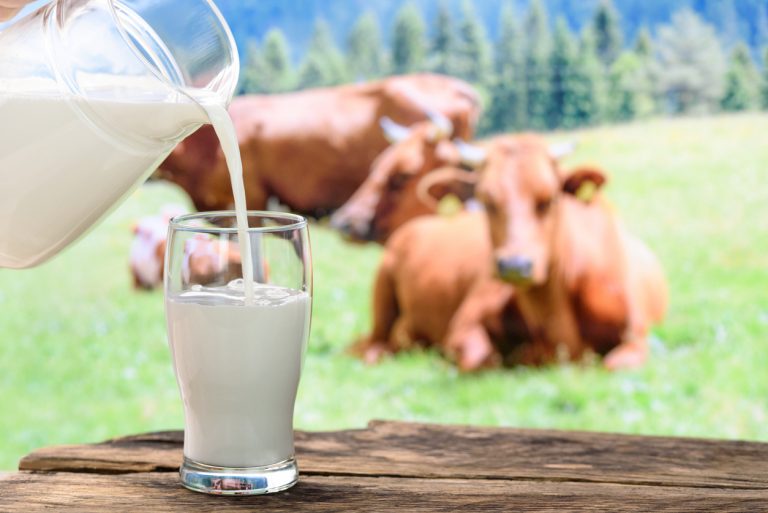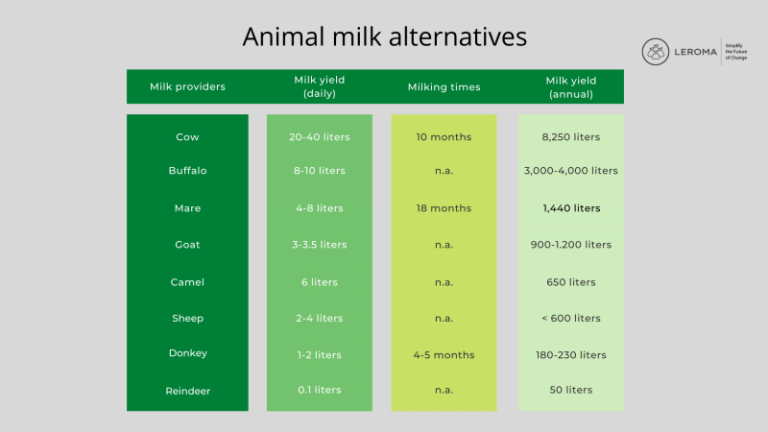Erzeugung und Konsum
In Österreich ist die Erzeugung von Schafmilch zwischen 2013 und 2019 um 11% auf 12.186 Tonnen angestiegen. Die Erzeugung von Ziegenmilch stieg in der selben Zeit um 29% an und kam in 2019 auf 26.521 Tonnen. Im gleichen Jahr wurden 3.781,337 Tonnen Kuhmilch erzeugt. Das entspricht einem Wachstum von 11,5%. Diese Zahlen zeigen zwar, dass die Erzeugung tierischer Milchalternativen ansteigt, aber die Kuhmilch sich immer noch mit Abstand an der Spitze befindet.
Das liegt weder an den höheren Preisen noch an mangelndem Interesse, denn obwohl es zu den anderen “Exoten” am Markt keine genauen Zahlen gibt, sehen wir, dass sie hierzulande immer mehr an Präsenz gewinnen. Tatsächlich besteht ein Nachfrageüberschuss, der aufgrund der geringen Verfügbarkeit noch nicht bedient werden kann. Deshalb werden die tierischen Milchalternativen wohl auch in Zukunft eher ein Genussmittel bleiben, dass nicht in denselben Mengen konsumiert werden kann wie Kuhmilch.
Im Folgenden möchten wir Ihnen die einzelnen Milchalternativen und ihre spezifischen Eigenschaften trotzdem einmal etwas genauer vorstellen:
Ziegenmilch wird von vielen unterschiedlichen Ziegenrassen gewonnen und kann pasteurisiert oder roh verarbeitet und konsumiert werden, wobei die Rohmilch am besten frisch genossen wird.
Sie hat eine feine, cremige Konsistenz und weiße Farbe sowie ein leicht süßes, würziges und säuerliches Aroma. Der Geschmack von Ziegenmilch wird allerdings häufig als sehr streng empfunden, denn sie nimmt schnell Fremdgerüche auf. Die Erfahrung zeigt, dass eine enge Zusammenarbeit mit den Landwirtinnen und Landwirten wichtig ist, um eine andauernde Qualität der Produkte zu gewährleisten. Der richtige Umgang mit der Milch hat große Auswirkungen auf die Qualität des Endproduktes, wie zum Beispiel auf den unerwünschten starken Ziegengeruch oder -geschmack. So kann eine schnelle Verarbeitung und moderne Hygienestandards direkt auf dem Hof die Aufnahme von Ziegen- oder Stallgeruch verhindern und somit den strengen Geschmack mildern.
Ziegenmilch wird aktuell vor allem für die Käseherstellung verwendet. Der fein-säuerliche Ziegenkäse liegt schon länger im Trend und der Bedarf steigt. Es gibt viele unterschiedliche Arten wie Camembert, Schnittkäse, Hartkäse und Frischkäse, die eine zarte, cremige Textur haben und sowohl mild als auch kräftig-aromatisch schmecken können. Zudem gibt es Käse aus Rohmilch, zum Beispiel von französischen Herstellern, die Aromaverluste durch eine weitere Verarbeitung der Milch vermeiden wollen. Diese Variante muss als Rohmilchkäse gekennzeichnet werden. Neben Käse eignet sich Ziegenmilch auch für Butter und Joghurts. Der Joghurt gerät schnell sehr flüssig und kann in dem Fall eingekocht oder zum Beispiel mit Ziegenmilchpulver verdickt werden. Hersteller, die von Anfang an das Milchpulver statt der puren Milch als Grundlage verwenden, können die Trockenmasse erhöhen oder weniger Wasser dazu geben. Sowohl das Pulver als auch die Milch können außerdem genau wie Kuhmilch zum Backen und Kochen verwendet werden. Das Pulver wird auch stark als Substitut für Babymilch verwendet, denn Ziegenmilch ist besonders gut verträglich, da sie weniger langkettige Milchsäuren enthält. Darüber hinaus wird sie nicht nur in der Lebensmittelindustrie eingesetzt, sondern auch in Pflegeprodukten wie Seife und Shampoo.
Schafmilch zeichnet sich durch ihren natürlich süßen Geschmack mit leichtem Mandelaroma aus. Sie hat eine cremige, fast schon sahnige Konsistenz und kommt bei uns hauptsächlich pasteurisiert und weiterverarbeitet zu verschiedenen Endprodukten in den Handel. Wegen ihres hohen Eiweißgehalts, der fast doppelt so hoch ist wie bei Kuhmilch, erreicht sie bei der Joghurt- und Butterherstellung leicht eine schöne, feste und cremige Konsistenz. Verbraucher lehnen die Butter aber oft erst mal ab, weil sie sich mit ihrer weißen Farbe von der gelblichen Kuhmilchbutter unterscheidet. Dafür erfreut sich der Schafskäse, zum Beispiel Frischkäse oder Weichkäse, zu dem die Schafmilch überwiegend verarbeitet wird, großer Beliebtheit. Bei der Herstellung von Weichkäse muss der Milch Wasser zugegeben werden, um den Eiweißgehalt dem von Kuhmilch anzugleichen. Aus Schafskäse kann dann auch Fetakäse hergestellt werden, der wohl das bekannteste Erzeugnis von Schafmilch ist. Aber nur wenn er in Salzlake gereift ist und aus Griechenland kommt, darf er sich wirklich “Feta” nennen. Wie Ziegenmilch ist Schafmilch auch als Pulver erhältlich und wird in Pflegeprodukten verwendet.
Büffelmilch wird vom Wasserbüffel gewonnen, der kaum anfällig für Krankheiten ist und so eine durchschnittliche Lebenserwartung von 25 Jahren hat, während der er auch als Milchlieferant dienen kann. Milchkühe dagegen werden schon nach vier oder fünf Jahren zum Schlachten aussortiert, da sie schneller krank werden und sich eine tierärztliche Behandlung aufgrund der niedrigen Milchpreise nicht lohnt.
Das wohl bekannteste Erzeugnis der Büffelmilch ist der Büffelmozzarella. Wer den schon einmal probiert hat, kennt den intensiven nussigen Geschmack, der sich für herzhafte Produkte wie Quark eignet, aber kaum bis gar nicht für Süßspeisen. Büffelmozzarella ist weicher als der herkömmliche Mozzarella aus Kuhmilch, der dagegen etwas gummiartig wirkt. Die Büffelmilch kann auch zum Backen verwendet werden und ist oft als Pulver erhältlich. Darüber hinaus ist sie Bestandteil von Masken, Badezusätzen und Cremes, die insbesondere zur Regulierung von Falten beitragen sollen.
Stutenmilch schmeckt süßlich und leicht nussig und ist im rohen Zustand extrem empfindlich und daher rasch verderblich, weshalb sie meist direkt pulverisiert oder für den Verkauf eingefroren wird. Das Pulver kann unter anderem zum Backen verwendet oder in Joghurts und Puddings eingerührt werden. Stutenmilch findet sich aber vor allem im Gesundheitssektor, in der Form von Cremes und Tabletten. Diese Tabletten werden in Apotheken und auch im Onlinehandel angeboten und sollen vor allem bei Hautkrankheiten eine mildernde Wirkung haben.
Während Schaf-, Ziegen- und Büffelmilch und ihre Erzeugnisse uns inzwischen sehr vertraut sind, verbindet der normale Verbraucher Esels- und Kamelmilch wohl eher mit der Kosmetikbranche. Wir werfen nun noch einen kurzen Blick auf diese beiden Substitute für Kuhmilch, welche sehr wohl auch für den Verzehr geeignet sind:
Kamelmilch wird von Trampeltieren und Dromedaren gewonnen, hat einen leicht salzigen Beigeschmack und wird hauptsächlich im Onlinehandel angeboten, meist als Pulver. Dort findet man auch Kamelmilchschokolade, und obwohl Kamelmilch nicht gerinnt gibt es auch Kamelmilchkäse, wofür die Milch künstlich zur Gerinnung gebracht wird. In der Kosmetikbranche wir die Milch vor allem für Seifen und Cremes verwendet, weil sie Lanolin und Elastin enthält, welche gut für die Haut sind.
Eselsmilch wird ausschließlich per Hand gemolken und in der Kosmetikbranche aufgrund ihrer hohen Hautverträglichkeit schon lange für Seife, Shampoo und Cremes benutzt. Sie ist aber auch für den Verzehr sehr gut geeignet, denn sie enthält viele Vitamine und Nährstoffe. Wegen ihrer Zusammensetzung, die der menschlichen Muttermilch ähnelt, bildet sie sogar eine Alternative für Säuglinge, die nicht gestillt werden können und gegen Kuhmilch allergisch sind.
Die hier aufgeführten tierischen Milchalternativen sind vielseitig und nicht nur für Allergiker eine willkommene Abwechslung. Lebensmittelhersteller können diesen Milchtrends folgen, um sich vom Wettbewerb abzusetzen und alternative Produkte zu generieren.
Rohstoffe zur Herstellung von Milch und Milchprodukten finden sie natürlich auch auf der Plattform von LEROMA.
Let‘s simplify the future of change!



